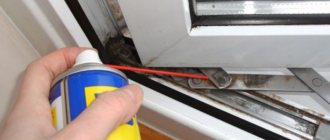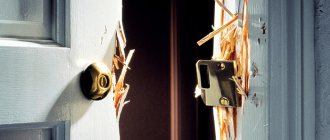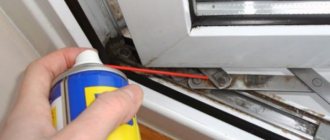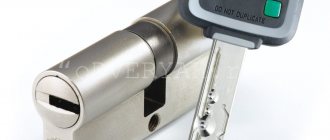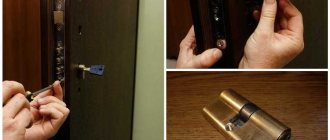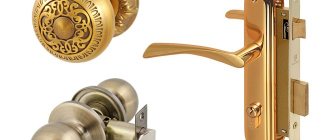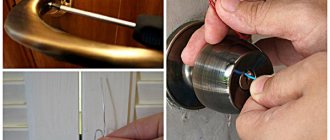Suddenly you find yourself in front of a slammed door to the next room and realize that you can’t open it? And it doesn’t matter what caused this - a draft, the tricks of a beloved pet, or your own negligence. The first thought in my head is how to open an interior door without a key.
Agree, even if you have never been in such a situation, no one is immune from this, and knowledge of how to quickly open an interior door will never be superfluous. In our material we will look at effective ways to open interior doors in a variety of cases.
There can be many situations with a slammed door, and the locking mechanisms are also different. Therefore, the solutions are significantly different from each other. We hope that the knowledge gained will be useful and you will not have to knock down doors or call the Ministry of Emergency Situations - everything can be done quickly and easily with your own hands.
How to open the door to the bathroom ↑
There can be many reasons why the door slams shut and does not respond to usual manipulations. For modern models with a built-in lock, the most common problem is a latch that has moved out of place, a jammed tongue, a key stuck in the hole, or a broken lock. Wooden structures without a lock often swell from excess moisture and can jam.
A ruler, knife or plastic card will help you open the door.
Preventive measures
To avoid such situations, a number of preventive measures need to be taken:
- The locking mechanisms on the doors should be well looked after (carry out routine repairs, check their functionality and lubricate them on time).
- Jamming devices should be replaced immediately.
- Have a spare set of keys for all doors. Provide them with tags.
- Do not install complex locking mechanisms on doors unless necessary. Sometimes you can give preference to simple bolts, latches and latches (especially if there are small children in the family).
- It is recommended to purchase locks that are equipped with devices for emergency door opening.
Timely preventive measures can eliminate unnecessary problems with interior doors.
If the tongue is jammed ↑
Most locks are equipped with a special spring-loaded latch. If the spring fails, the tongue stops moving and supports the door leaf. To release it, the part must be squeezed out or simply moved aside. The easiest way to do this is from the side where the door opens.
Any flat and thin object will come to our aid: a rounded table knife, a thin chisel, a ruler, a flat screwdriver, a plastic card, etc.
- We insert the tool into the gap between the jamb and the canvas in the place where the tongue is located.
- We tilt the tool towards the door handle while pressing it. If everything goes correctly, you can feel the tool sliding along the cut of the tongue.
- Now you need to press it away from you so that the tongue can go into the lock. Pull the door towards you or push it, depending on where it opens.
If you have to open the structure from the side where the tongue does not have a cut, insert the tool from above. Then we tilt it diagonally to reach the inside of the lock. Now press the tongue firmly.
You can open the door without a key using wire or hairpins
Latch
A very popular device on doors leading to a bedroom, toilet or bathroom is a latch. Modern models are equipped with rotating miniature handles, which are located on the side of the room. On the reverse side, part of the lock is represented by a plug. Sometimes a key lock is installed instead if we are talking about a living room.
Since sometimes you need to open an interior door lock without a key, you have to look for alternative ways to turn the latch tongue. The easiest way is to use a thin flat object, it can be a screwdriver, a plastic card, a file or a knife; sometimes you can open the lock with your fingernail. This is possible if there is a plug with a slot or recess on the back side. For smooth button plugs, you can use pliers. You just need to turn it and the lock will open.
Sometimes it is possible to move the tongue away using the same devices, but you need to get into the gap between the leaf and the door frame. If the tension is not strong, moving the latch will not be difficult.
A slammed door latch can be opened with a thin object by moving the tab
Another option is a latch. It is installed on top of the door. How to open such a mechanism? You can try to move it through the gap between the door and the trap. If this does not work, then the easiest way is to use force. Typically, self-tapping screws easily fly out of the canvas, although they can damage its surface.
Key on the other side of the door ↑
Interior doors, and even more so bathroom doors, are rarely equipped with a lock and key. However, this also happens. Problems with such locks seem to be the most difficult. And indeed: to solve them, the most important thing is not to rush. Any careless movement, irritation and anger can only aggravate the situation. If the key is simply jammed, do not yank it with all your expression, it may simply break and then it will be even more difficult to open the door.
If the door slams and the key remains outside, we will act carefully. Our goal is to get the key from the lock. Place a cloth or newspaper under the door (at the location of the lock, of course) and try to knock out the key with gentle pushes. If this does not help, any thin object that can be used to push the key into the keyhole will come to the rescue - a knitting needle, a needle, a paper clip or wire. As soon as you hear that the key has fallen out, pull it on the newspaper towards you through the crack under the door. Ready!
Tongue problem
Another problem: if the mechanism is not equipped with a latch, but the door does not want to open, even if the handle is pressed all the way. Breakage may occur due to improper functioning of the tongue. To solve the problem, you will need a tool with a flat end that will fit into the small gap between the canvas and the box. This tool must be durable so as not to break, as this will further aggravate the situation. A working tool can be a metal ruler or a durable knife.
The key broke in the lock ↑
When the key is stuck in the lock, we usually try to somehow turn it. And sometimes this ends in disaster - the key breaks and remains in the lock. First of all, try to avoid such a situation by using the tips above. But if this does happen, look around to see what you can use. Pulling out a broken key is much more difficult than squeezing out the tongue or knocking out the key from the other side.
Outside ↑
If you are outside, then the easiest, fastest and most relaxing method to solve the problem of a broken key is to simply disassemble the lock using a screwdriver. But that's if you have the tools at hand. What if you stayed inside?
From the inside ↑
You can wring out a lock with a stuck key using pliers. This option is suitable if at least some part of the key sticks out of the lock, which you can grab onto. In addition to pliers, tweezers are also suitable. Your movements must be careful. If there is an opportunity to lubricate the lock parts with at least something, take advantage of it.
A self-tapping screw will help you remove the broken key from the lock. In this case, you need to hit the end of the key with a self-tapping screw with pinpoint precision, and methodically “drill” a hole with the self-tapping screw, thereby fixing it in the key. And only when you are sure that the screw fits securely enough, you can try to turn the key or use pliers and pull out the fragment.
As a last resort, try using the same knitting needles, wire, needles, awls and any other thin tools that can be used to “grab” a piece of the key in the keyhole and loosen it. It is advisable to lubricate the tools and the lock before doing this.
Opening entrance doors
Opening entrance doors is a more difficult task, since they usually have at least two locks. You should think carefully before trying to solve such a problem yourself: an unprofessional approach can have a detrimental effect on the condition of the door itself, and replacing a metal entrance structure is not a cheap pleasure. When getting started, do not forget that the main goal is to open locked locks, and not to break into the door.
The process for this activity will depend mainly on the type of lock. If the reason for opening the door was a broken key, you must first remove the fragment from the cylinder. To do this, first pour a few drops of lubricant into the keyhole: WD-40 or machine oil. It will take 15–20 minutes for it to spread evenly throughout the well, after which the debris can be removed. If a small part of the debris protrudes out, this simplifies the task. It should be carefully grabbed with pliers or tweezers and, swinging from side to side, pulled out. If it is not possible to catch the fragment from the outside, you will need two thin objects, for example, an awl. We grab the stuck part with the tips, swing it and try to move it. When the fragment is removed, you will very soon open the door to the apartment: a good master will make a duplicate of the two broken halves, and this will solve the problem.
Now let's look at ways to open a door without a key if the key has been lost and it is not possible to make a duplicate.
Options for opening a cylinder lock
If you have set the task of opening a cylinder lock and keeping it in working condition, then you need to have masterly burglar skills. Such devices have a high level of secrecy, but for an experienced master it will not be difficult to open the cylinder lock with a hairpin or a regular paper clip, although it would be more convenient to use master keys. Let's consider an emergency option: how to open a door lock with a paper clip. We will use it as a master key, but we will also need a “roll-up”, which will serve as a screwdriver. The task is to straighten the paper clip, slightly bend the edge with a hook and insert it into the cylinder. Now you have to rely on your ears. Our task: to set the pins of the secret mechanism in the correct position. They must be lifted one by one, using an improvised master key and a roll. As already noted, this is a very difficult task, which is almost impossible to cope with without the proper skills.
There is a less delicate, but more accessible way to pick a door lock . It will require tools: an electric drill with a drill designed for metal, a flat-head screwdriver and a hammer. Sometimes a lock can be picked without drilling, so you should try this option first:
- insert a flat screwdriver into the cylinder as deeply as possible;
- using considerable effort, try to turn the screwdriver inside the lock;
- upon successful attempt to pull out the screwdriver, along with which the secret should be removed.
This completes the task - the door can be opened. If this method is unsuccessful, you will have to take a drill. We point the drill directly into the larva and drill until we go through the entire secret to the end. After that, we take out the larva and open the door.
It is important! The method of drilling or knocking out a cylinder lock is completely powerless if the device is protected from hacking.
Methods for opening a lever lock
Using master keys Drilling
The lever mechanism can be broken off or you can try to open it in a delicate way.
To break the lock, it is necessary to remove the main pin of the structure, which is responsible for moving the levers. To do this, you will need a drill with a metal drill, a hook or bent strong wire, and a paper clip. But even if you have a tool, it will not be easy to complete this task, since you need to drill strictly in the place where the support point of the secret mechanism is located. When it is drilled, you need to insert a bent hook into the hole and turn it. In this case, all the levers move freely, and the door can be opened. As with cylinder mechanisms, this method is completely ineffective for burglary-resistant locks.
Now let's look at how to open a door lock with a lever lock, using master keys or objects that can replace them: paper clips, hairpins, pins. Opening lever door locks is performed with two master keys. The first is inserted into the keyhole until it touches the main board. The second is necessary to alternately select the desired position of the levers so that the main pin moves. You should be prepared for the fact that this process can take a lot of time and end in complete failure if you have never opened locks before. Therefore, it is more advisable to invite specialists.
How to open a rack lock
If a rack and pinion mechanism is installed on the entrance structure, opening the door lock without a key will not be very difficult. Since the rack lock is well protected from rough influence, we will not consider options for how to break into the front door. Having a regular tool at hand, we can carefully open the mechanism in one of three ways.
- Let's take two flat screwdrivers. They must be thin in order to freely enter the well at the same time. First, insert one screwdriver into the hole. We need to place it on the notch of the crossbar and move it to the side. Then insert a second screwdriver and use it to fix the position of the bolt. We repeat these steps until the lock is opened.
- We can open the front door locks using a wooden wedge key. To make it we need a wooden wedge made of soft wood. The size must correspond to the parameters of the well. The wedge needs to be driven into the hole, then pulled out. There will be noticeable marks on the surface of the wood. You will have to trim the wood a little to make something like a key and open the door.
- This option is only available if there is a distance between the door leaf and the frame into which a crowbar can be inserted. The tool is placed in the gap between the jamb and the door, then pressed until it stops. We have a gap where we can insert a flat-head screwdriver and use it to move the bolts inside the lock.
Opening a padlock
Method 1 Method 2 Method 3
Padlocks are not very strong, but they are often used to protect utility rooms, sheds, and basements. If keys are lost, such locks are usually broken into because they are of little value. Here's how to break padlocks:
- Take two open-end wrenches and insert them so that each of them grips one shackle of the lock. The keys should be in contact with their side ribs. The free edges of the keys must be pulled towards each other. As a result, part of the lock near the latch breaks.
- We cut out a small plate from a tin can and bend one edge. With the unbent side, insert the blank into the slot that separates the lock body and the opening shackle. Use a screwdriver to push the plate deeper. As a result, the latch opens.
- For the third option we will need a self-tapping screw and a nail puller. We screw the self-tapping screw into the lock cylinder, then we hook it with a nail puller and pull out the cylinder.
How to open a door without a key ↑
For example, the key is somewhere in the apartment, and you are sitting in a locked bathroom. How to open a door without a key? In this case, we will try ourselves in the role of real burglars. Hairpins, knitting needles, wire, a thin nail file and tweezers, needles and pins will be used. Your goal is to immobilize everything that moves in the castle. As a rule, interior door locks have a fairly simple design, so there are few pressing mechanisms. Slowly feel them from above and below and try to immobilize them. Once this mission is completed, slowly turn the tools in the direction of turning the key. If you win, you will hear a characteristic click
Required Tools
In order to open interior doors without a key, you may need the following tool:
- flat and Phillips screwdrivers;
- hammer;
- pry bar, chisel;
- pliers;
- angle grinder (grinder);
- hacksaw for metal.
If it is not possible to use such tools, then you can use any available means. A straightened paper clip, knitting needle, nail file, or other long metal object will work to open the small round keyhole.
Radical measures: how to knock down a door without damaging it ↑
What if nothing helps you? For example, you are sitting locked in the bathroom and you have absolutely nothing at hand that could help solve the problem. Don't break the door just because the lock is broken? It is possible to knock out or, rather, “squeeze out” the door entirely if it opens outward. First, you need to apply something soft to the shoulder that will have to be “worked,” for example, a rolled up towel. Then we press our shoulder forcefully into the structure, directing the force to the area near the edge of the opening. At the same time, we try to stand so that our feet rest against something, and with our free hand we hold on to the wall so as not to fall when the door opens.
You may also be able to remove the door frames, thereby disassembling the door.
To open doors with glass inserts, simply pull out the decor
For a design with a glass insert, simply remove the decor. To do this, carefully remove the glazing beads that press the glass and take out the decorative fabric. Then we try to open the door through the resulting hole. If you can't remove the glass, you can break it, but try to be patient - you will probably succeed.
By gaining access to both sides of the lock, it is much easier to dismantle or open it.
A wooden panel can jam due to excess moisture. The tree absorbs it even from the air, swells and jams the structure. If this is the case, you can try to speed up the drying of the wood by warming it up with a heater or hairdryer. At the end of the process, it is advisable to trim the problem areas a little so that the unpleasant situation does not recur.
Installing a Latch Door Handle
Even if the handle was not completely dismantled, everything will have to be returned to its previous state. Therefore, you need to know not only how to remove, but also how to install the handle on an interior door with a latch.
The whole process is conventionally divided into three main steps: marking, making holes, direct installation and fastening . Each company may have nuances in installation, so step-by-step instructions are attached to any fittings.
Tools
Each master approaches any work from his own perspective, so the tool will be different, but the standard is as follows: a spiral and a feather drill, a chisel, a wood crown. A pencil, a screwdriver, a ruler, a drill, and a tape measure will also come in handy.
Tool for opening a jammed lock
Marking
Most often, door manufacturers indicate a place for the handle, and it is advisable to install it there. Take a distance of 80-120 cm from the floor , and if there are other door panels nearby, then the handles will look more advantageous at the same distance.
An angle is applied to the door at the selected height and a line is drawn. Next, mark the place for the tongue of the handle, mark it on both sides and put a mark for the future hole.
Drilling
Using a tool with a wood bit, a hole is drilled on one side, but not through, and then finally on the other.
The hole for the tongue is prepared using a guide drill. This part of the work is done most carefully, because there is very little space left to the edge of the door leaf . Knock out excess wood from the canvas with a chisel, periodically applying the lock plate in order to correctly place the plate in the same plane with the door end.
How to open a door from the inside using improvised means ↑
All of the above tips are suitable for use both outside and inside. The only difference is what tools you can find in the bathroom. Remember that if you don't have pliers, you may have tweezers or tweezers. An awl and wire can replace hairpins. And a file is a nail file. A folded cardboard packaging of cosmetics and a spoon will help you press out the tab in the lock. You can also pick up door frames or glass decor cladding using a nail file or spoon. Get creative - even though you probably don't have a full set of tools in your bathroom, there are probably plenty of items in there that will help you! In all other respects, follow the advice above, based on your situation and the side of the door opening.
We looked at the most common problems with opening bathroom doors. In fact, there are many more of them. You can try to deal with them yourself. However, you need to be firmly confident in the correctness of your actions, otherwise you can only aggravate the situation and lead to damage not only to the lock, but also to the door leaf. If you have doubts about your competence, it is better to invite professionals. They can help open any door structure. And, of course, you should not skimp on locks and fittings in order to initially prevent funny situations.
Was the article useful? Tell your friends:
Remove from hinges
The most common solution to the problem of a closed door, the one that first comes to mind, is, of course, removing the door from the hinges. Since it is not always possible to open a room door without using a key using master keys, this method is the best alternative option.
Regular card loops consist of two parts. If there is enough clearance between the door and the frame, you can try to remove them from the awnings. Sometimes it is possible to unwind the details.
The disadvantage of this method is that it is not always possible to carry out such an operation. This is especially difficult and almost impossible if hidden mechanisms are used.
Removing the door leaf from the hinges is only possible if there are sufficient gaps
How to quickly open a padlock
Opening a padlock mechanism without a key is quite simple because such models do not have high strength. They are often used on outbuildings to restrict access to utility rooms or basements.
As with other mechanisms, to open a padlock without a key yourself, you need to know its design. However, there are several types of barn-type constipation:
- An open mechanism in which the door has a curved shape.
- A closed device with a locking part completely hidden in the housing.
- Semi-closed lock with a pin instead of a latch. The locking element is partially hidden in the housing.
- A mushroom-shaped hinged lock, which has a pin instead of a door, almost completely hidden inside the body.
To open a padlock, you also need to know the type of locking mechanism inside the product. The basis of this part of the locking device can be a cylinder, a screw, levers, or disks. There are also models of padlocks that are closed by setting a code. The method for opening a padlock without a key depends on the type of internal mechanism.
First way
An open locking mechanism with a protruding door can be broken using an ordinary crowbar. You can also use a hacksaw. With this tool you will be able to saw through the darling.
A fairly simple way to simply break the lock if you don’t have a crowbar
If you have two wrenches, you can break the lock. To do this, you need to attach a tool to each darling. In this case, the keys should touch each other with their outer edges. At the next stage, you need to try to connect the free parts of the tool with force. After this action, the mechanism should crack in the latch area.
Second way
This option is implemented using a small cut piece from a tin can. It is pre-bent at one edge. Then the straight side of a piece of tin is inserted into the gap between the locking element and the body. The plate is then pushed into the lock and turned. As a result of these actions, the locking mechanism is moved to the side.
Opening a lock with a plate
Opening the lock with a hairpin
A broken lock can be opened with something as simple as a hairpin. You could see such a picture more than once in the movies. But in real life, not everything is so simple; this method is not suitable for all locks.
The pin needs to be divided into two parts, one of which must be threaded into the lock, and the other one should try to move the pins, while simultaneously turning the lock first. Instead of a hairpin, a strong wire will also work, but it must be used carefully so that its parts do not remain in the lock.
When opening a lever lock with a wire, you need to pull it towards you as hard as possible and try to move the levers.
What to do if the interior door slams shut?
One of the most important attributes of every apartment or office space is an interior door. Such doors divide the room into rooms and visually limit the space.
The most important role is played in office premises. They come in specific types and are made from a variety of materials to suit budgets and needs.
Often, homes and offices are equipped with locks. These are not very complex locking structures, however, they perform a number of important functions.
A lock can restrict access to a room where important documents or valuables are stored. It also helps to provide privacy and limit unwanted presence, thereby providing a calm or intimate environment.
What to do if you can’t open the lock
It may be that the lock cannot be opened. The door to the bathroom closed from the inside, what should I do? Breaking down the door is the last case, but it doesn’t have to come to that. Try to open it in a civilized way. For this:
- Try to remove the door from its hinges. Carefully inspect the hinges, remove the inner rod. Remove the door in the opposite direction;
- Insert the blade of a knife, ax or nail puller into the gap between the door frame and the door leaf. Try to press the door away from the opening to release the lock tongue;
- After removing the casing, cut out a small part of the area where the crossbar trim is located;
- The situation is easier if the door has glass inserts. They need to be pulled out carefully. If that doesn't work, just break it and you'll gain access to the lock. New glass is easy to install.
After such operations, you will have to put the door in order. It is not recommended to turn the key forcefully, as it can break and make the situation worse.

